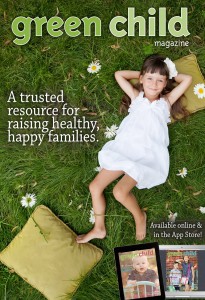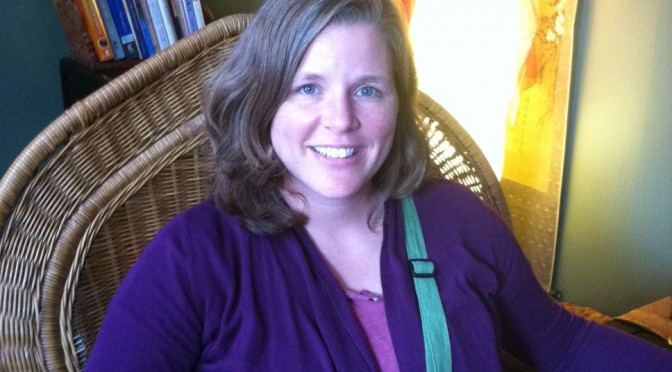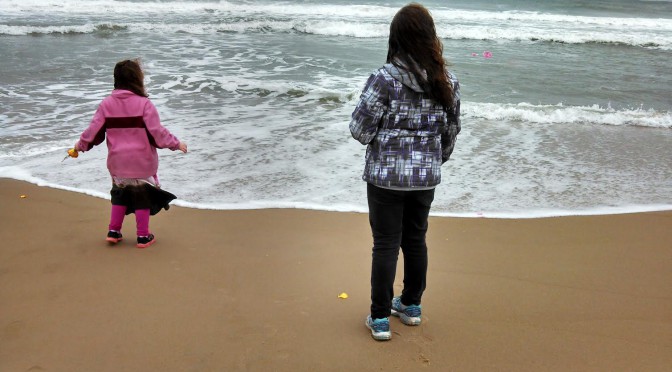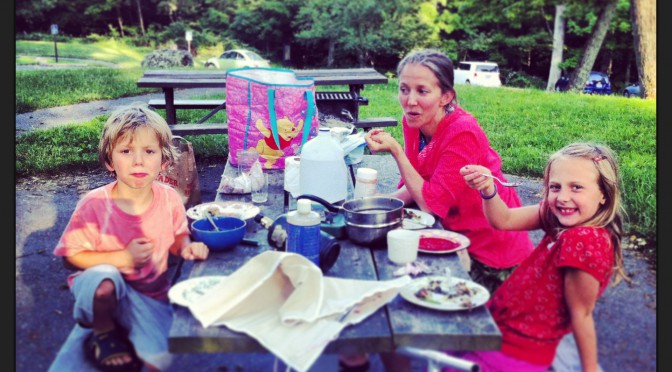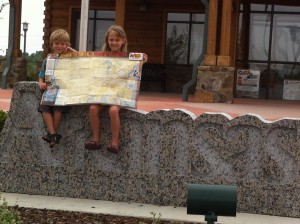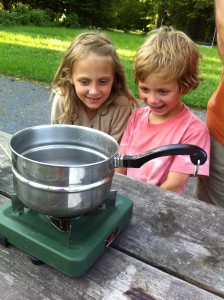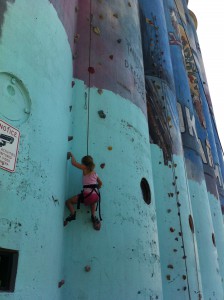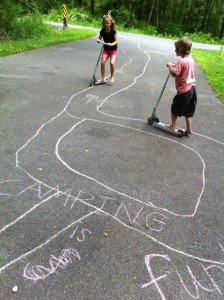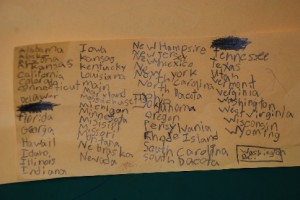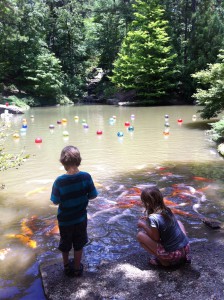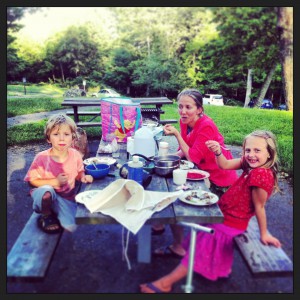As a psychologist, I spend the majority of my time retraining
people’s behavior that arises out of the skills missed in childhood, skills that are circumvented, repressed or ignored. These skills
include coping, executive functioning, language and communication, emotional regulatory, cognitive flexibility and social.
Daria Brezinski, PhD, lives in Charlottesville, Virginia, USA. She is a psychologist and the Executive Director of What Wize Women Want.
Most of these skills are acquired through children’s play. Here are guidelines for parents on purchases and activities to enhance creativity, intelligence and promote a healthy psyche:
Clever Toy Marketing Strategies
 Clever marketing campaigns convince consumers into spending thousands of dollars on toys and trinkets as the means to raise happy, healthy, spiritual children while subliminally promoting a pattern of long-term behavior to constantly consume and crave more, bigger and better rather than nurturing the creative world of the child.
Clever marketing campaigns convince consumers into spending thousands of dollars on toys and trinkets as the means to raise happy, healthy, spiritual children while subliminally promoting a pattern of long-term behavior to constantly consume and crave more, bigger and better rather than nurturing the creative world of the child.
The clever strategies focus on developing products that target the deficiencies in our culture: spiritual, emotional, bonding, socialization, family relationships and community. The lines between these deficiencies and capitalism — between hero/heroine/ saint and sinner/evil-doer — are blurred in advertising, media, movies and toys. The delineation line requires advanced discrimination skills, which children do not possess.
At every turn, children are offered a confusing mix of unhealthy spirituality, emotionality, common sense, morality and entertainment. Adults are the main interpreters of choosing the best modalities for their child, not corporations.
Entertainment vs. Play
 A major confusion among parents is the difference between entertainment — being the observer and acted upon — and play: being an active participant. Play is imperative in integrating culture, rules, spiritual laws and allowing the soul to emerge. Play is the means by which a child becomes master of the world. Play is the source of richness of a child to mimic real-world circumstances. It is the greatest source of learning. Habits developed during play become incorporated in adult daily life.
A major confusion among parents is the difference between entertainment — being the observer and acted upon — and play: being an active participant. Play is imperative in integrating culture, rules, spiritual laws and allowing the soul to emerge. Play is the means by which a child becomes master of the world. Play is the source of richness of a child to mimic real-world circumstances. It is the greatest source of learning. Habits developed during play become incorporated in adult daily life.
Real play contains no rules or guidelines. It is unorganized and spontaneous. It enables the child the freedom of exploration. This definition eliminates those toys sold in the marketplace with fixed and immutable rules. In the long run, entertaining children develop behavior patterns that keep the child in need of more stimulation from external sources and less reliance on their inner voice, intuition and creativity.
Less Is More
 The objects of play must be simple and safe, and allow imagination to flourish, freedom of movement and range of complexity. The colors, materials, textures, size and shape of the play object are just as important. The more removed from nature, the less value the toy has in play. Simple, natural materials with earth tones and earthy materials are all characteristics that develop brain-eye-hand coordination, heart, imagination and joy of expression. These are the skills that are necessary when boredom, confusion or depression sets in.
The objects of play must be simple and safe, and allow imagination to flourish, freedom of movement and range of complexity. The colors, materials, textures, size and shape of the play object are just as important. The more removed from nature, the less value the toy has in play. Simple, natural materials with earth tones and earthy materials are all characteristics that develop brain-eye-hand coordination, heart, imagination and joy of expression. These are the skills that are necessary when boredom, confusion or depression sets in.
In my opinion, the purpose of toys is to develop creative imagination and intuition, not to entertain. After all of the boxes have been opened on Christmas morning, the greatest joy for young children is playing in the empty boxes. This is because large, empty boxes enable exploration of the “child world.” In a box, one can be exploring a cave, flying a plane, driving a car or just finding a sense of peace and silence from our hectic world. Empty boxes are a very important toy.
The best types of dolls are those that allow the child to “fill in the blanks.” Rudolf Steiner, founder of the Waldorf Schools, explained that dolls made of cloth, with thread for eyes, nose and mouth, allow a child more freedom and creativity of expression. Interchangeable clothing made of soft cotton, not synthetic materials, allows children to learn to button, snap, and tie and remove clothing that will later be translated into their own clothing. The textures of cloth enable the child to develop their sense of “feeling” textures, something plastic does not promote.
Dolls of an animal nature are preferable to human in the early years, because children, until the age of 8, relate to animals. Paper dolls for older children are excellent, as well. With allowances for making personal accessories and clothing, paper and cloth dolls can open a world of joy, creativity and skills to play. Dolls like Barbie, Ken, and GI Joe are hard plastic with plastic accessories and inappropriate body dimensions, subliminally representing a distorted value system that children replicate in play and then life.
The child’s room must be a source of peace and comfort. If the room is filled with bright or psychedelic colors, televisions, computers or video games, there is little peace for the child’s mind to integrate information, much less sleep.
Frank Lloyd Wright, author of Complete Works, Vol. 1-12, recognized that peaceful earthy environments are more conducive to health with emphasis on colors (pastels and earth tones), shapes (curved) and child sizes that enable a child to get in touch with the inner self. The harsh colors (psychedelic), bright lights (florescent), textures (computer generated) and cluttered spaces of today’s world do not allow the eye, senses, brain and heart to develop fully. Rooms that have these harsh features overstimulate the retina and do not send proper signals to the brain. Whole Parent/Whole Child by Polly Berrien Berends and Open Connections by Susan Shilcock and Peter Bergson offer environments for organizing a child’s space.
According to research, pre-birth babies have greater awareness of their environment than adults ever conceived or considered previously, both the internal world inside the mother as well as the external. After birth, babies recognize the faces of their parents and other loved ones within the first weeks of life, so a mobile in the child’s crib with faces of loved ones, for example, reinforces a safe and secure environment as well as promoting hand-eye coordination. Record the voices of loved ones to play for the child, along with soft music, as the mobile spins and keeps the environment calm.
Creative Intelligence
 For hand-eye coordination, toys and activities to consider include origami, knitting and crocheting, magnetic marbles (which teaches color sorting and classifying), drawing and painting, putting things together and taking them apart (like old watches or electrical appliances), tangrams or Cuisenaire rods. Put pencils, screwdrivers, little saws, hammers and paintbrushes in their hands as soon as they can hold them—with an atmosphere of encouragement from adult—and children will use these tools throughout life. Allow them to move, climb, explore and stretch their bodies. The age for these discoveries is as early as 1.
For hand-eye coordination, toys and activities to consider include origami, knitting and crocheting, magnetic marbles (which teaches color sorting and classifying), drawing and painting, putting things together and taking them apart (like old watches or electrical appliances), tangrams or Cuisenaire rods. Put pencils, screwdrivers, little saws, hammers and paintbrushes in their hands as soon as they can hold them—with an atmosphere of encouragement from adult—and children will use these tools throughout life. Allow them to move, climb, explore and stretch their bodies. The age for these discoveries is as early as 1.
Wooden blocks in a variety of shapes and sizes, Lincoln Logs, Legos and Construx help to develop focus of attention, patience, visual discrimination, hand-eye coordination and pre-math skills. Children learn about stacking, size, shape, classifying, categorizing and dimensional space through the use of building toys. Legos and Construcx are good for children after the age of 6, because the plastic configuration is more complicated than wood, which is best for younger children. These toys build much more than just structures.
To promote language development, purchase toys that do not speak. Chatty Cathy, Teddy Ruskin, talking books and learning/talking toys are novel, and manufacturers praise the capability of them as teaching tools. However, the quality of the voices in any mechanical toy hinders language development, because the sounds are distorted unlike human speech. Children get a distorted sense of language through these toys and often form inappropriate and false impressions, incorrect pronunciations and misinformation that are carried through to adult life.
To stimulate language development, talk to the child, record your own voice, read to your child, speak to them at meals and while walking, riding or shopping. This builds language skills as well as auditory discrimination. Bonding is another added benefit to talking with a child, one which is highly underrated. Contrary to media hype, the less mechanical the means, the better the child will be equipped for real-life relationships in communication, which is the function of language.
The greatest form of language development, and any type of
creative intelligence, is reading to your child from pre-birth.
Language exposure from a loved one is statistically more influential on a child than from anyone else. Reading also allows the child to form pictures in their minds—the foundation for intuition and creativity—builds attention span and develops vocabulary. A young child can listen to stories many levels above his or her reading level and comprehend the essence of the story. Early reading aloud develops essential skills for later life, like story comprehension, decoding skills and getting the main idea. Generally, the Caldecott and Newbury award-winning books are the best. You can find these titles anywhere.
For physical coordination, children can be encouraged to move and explore, sing and dance, jump and run. The environment of play is nature. Climbing trees teaches a child coping skills, spatial relation, self-confidence, courage, persistence, patience, tolerance, tenacity, hand-eye coordination, learning balance, dimension, depth perception and a host of other skills as well as for being an invigorating, healthy exploration into the world of nature. Their own inner limits are tested and strengthened without fearful grown-up intervention or observation: An adult’s fear is a child’s fear. The rough bark heightens the sense of touch. The aromas of the pines and other vegetation stimulate the senses.
Unlike its counterpart in the plastic concrete playground whose smooth, hard surfaces and toxic materials have no texture to
stimulate—except over-stimulation from bright colors—exploration of the animal and insect world, dirt, sand, leaves and grass enables children a complex and realistic perspective on life from a variety of angles. John Holt’s How Children Learn is an excellent source for the natural exploratory play learning.
In order to gain a sense of self-esteem and comfort with their
bodies, children need to self-exploration. From the time they are infants in the crib, children must be allowed to touch their bodies to become comfortable in their own skin. Knowing the body gives the child a sense of awareness of self that is healthy. Mirrors and
dress-up for both sexes are acceptable ways for this exploration. Although this activity is considered for young children, it is one that suits well into teen years. Children love Halloween and any other opportunity to “dress up” and pretend to explore various sides of themselves. In the art of pretending, a child merges with the values, actions of caregivers, the environment, society and habits of culture. You can know what a child is thinking and what ideas have rooted in the psyche by observing his or her play. Ideas and knowledge will be reflected in pretend play.
The arts are very, very important for a child’s exploration of the world. The arts enable children to get in touch with their passion, soul and inner core. Children need to be encouraged to draw at very early ages with soft pastel paints, light graphite pencils and pastel pencils. The 500 colors in a box of crayons are unnecessary as well as the psychedelic colors of markers. A child can learn to mix and blend colors, to create various shades through trial and error, which builds self-esteem, courage, stamina, perseverance and other skills.
Purchasing art books and paper is very important for children to get in touch with their souls. Coloring books, dot-to-dot and coloring in lines hampers creativity. Encourage the free drawing of lines exploring the entire sheet of paper, and doodling are very important skills that are dismissed in culture today while children, missing this adventure, satisfy that urge by resorting to graffiti. Children need the freedom to explore space both on the paper and off in order to gain a sense of self.
Allowing them to bang on musical instruments like piano, drums and guitar—no matter how awful it sounds—eventually turns into recognizable music. Children proficient in music are generally also exceptional in math. However, there are many mainstream children’s songs that have deep messages that touch the child’s soul, as well. These include the genius of the Jim Henson and other songwriters. Music is like a mantra as it is repeated over and over; it becomes part of the belief system just like any other subliminal repeated message. Choosing the best lyrics and music that touch the heart and soul will enhance the developing child.
Balance is both an internal and external skill that complement each other. Maintaining equilibrium while playing has an effect on coordinating a life of balancing all aspects of life. Along with nature, toys that swing, rock and move are important for building equilibrium in the brain of a child. Rocking horses, spinning around, holding a child in a rocker and wooden swings are excellent. Even a rope tied to the branch of a tree is a learning tool. Trampolines stimulate the immune system and help the body excrete toxins in addition to teaching the body alignment. These toys calibrate the inner child, inner ear, brain and can often be a source of centeredness and peace.
Look for child-sized toys. Marketing advertisements promote the notion that treating a child as an adult, dressing them as adults and encouraging them to behave like adults will entrain adult values and skills. The more appropriate strategy is to create a child’s world in the home. Keep the tools as close to a child’s level as possible. Buy a child-sized broom, dustpan and shovel as well as keeping a child-sized table and chair in the kitchen. Place the pots and pans at the child’s level. Allow them to pretend to cook, clean and follow along in the kitchen—more bonding experiences. Mimicking adult behavior is imperative but at the level of the child.
Children love to clean and pretend to be adults. Allow them to spread their things all over the kitchen while you are cooking and play in the dish water. Modeling adult behavior from the child-sized perspective will entrain behavior, which is a much better approach than at some magical age, attempting to arbitrarily teach them tidiness skills. It takes time to teach a child these skills, and in our hurry-up world, we find little time to teach them and allow them to help. Time spent teaching them self-help skills as a child, at a child’s ability phase, will train healthy members of society.
Beware of Screen Time
 Television is a powerful tool that distorts the mind into believing subliminal messages that are repeated over and over, entraining the child to believe what is heard, which then becomes part of the belief system. Electronic toys, games, television, virtual reality and computers are detrimental to a child until age 12 when the child is able to think cognitively and has developed social skills, a conscience and eye-hand-brain coordination.
Television is a powerful tool that distorts the mind into believing subliminal messages that are repeated over and over, entraining the child to believe what is heard, which then becomes part of the belief system. Electronic toys, games, television, virtual reality and computers are detrimental to a child until age 12 when the child is able to think cognitively and has developed social skills, a conscience and eye-hand-brain coordination.
What these electronic devices can do, if overused, is override the limbic system of the brain so that children have a distorted sense of reality. These devices are also highly over stimulating to a child’s mind and sense of being. It keeps them in need of constant gratification to stimulate secretion of pleasure hormones in the brain.
Sleep and Silence
 Sleep is imperative to a healthy life, because in the dream state, problems are worked out; information is stored and is filed away for future reference. Some children have difficulty falling asleep at bedtime when read to because the imagination is activated and the working mind explores options. Others are confounded by the electromagnetic energy, computers and television in the room. Even the digital alarm clock or noises from outside can be disturbing to the sensitive child.
Sleep is imperative to a healthy life, because in the dream state, problems are worked out; information is stored and is filed away for future reference. Some children have difficulty falling asleep at bedtime when read to because the imagination is activated and the working mind explores options. Others are confounded by the electromagnetic energy, computers and television in the room. Even the digital alarm clock or noises from outside can be disturbing to the sensitive child.
An essential key to creative intelligence is to be allowed to go to quiet places, quiet time and just be or allow the mind to drift off staring into space. When a child appears to have a blank stare or the gaze seems empty, the blank or “far off” look is the brain synapses getting in touch with creative intelligence, making important connections. It is connecting synapses and discordant thoughts into a whole: putting the puzzle pieces together.
An essential key to creative intelligence is something totally lacking in a child’s world of today: silence. Allow time for a child’s quiet space. This does not include nap time or rest. There needs to be a place in the home to allow a child space to be in silence.
As a culture, meditation has become popular, because this reconnects the art of getting in touch with ourselves through silence. Children need to be allowed to go to quiet places and just be. When a child is calm, they become more sensitive to the finer qualities of life.
All children learn and behave differently: kinesthetic (touch), auditory (hear), visual, olfactory (smell) and gustation (taste). Parents are the custodian of a child’s sense of being in this world, self-knowledge of themselves and world knowledge. The purchase of toys, games and activities is a conscious responsibility to be seriously undertaken. A child’s future depends on parental judgments and choices. Create a safe, peaceful, creatively stimulating environment, and a healthy child is the result.








